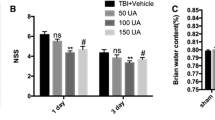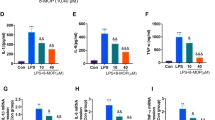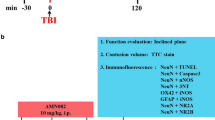Abstract
Traumatic brain injury (TBI) is a leading cause of mortality and disability in children and young adults worldwide. Neurologic impairment is caused by both immediate brain tissue disruption and post-injury cellular and molecular events that worsen the primary neurologic insult. The β-lactam antibiotic ceftriaxone (CTX) has been reported to induce neuroprotection in animal models of diverse neurologic diseases via up-regulation of GLT-1. However, no studies have addressed the neuroprotective role of CTX in the setting of TBI, and whether the mechanism is involved in the modulation of neuronal autophagy remains totally unclear. The present study was designed to determine the hypothesis that administration of CTX could significantly enhance functional recovery in a rat model of TBI and whether CTX treatment could up-regulate GLT-1 expression and suppress post-TBI neuronal autophagy. The results demonstrated that daily treatment with CTX attenuated TBI-induced brain edema and cognitive function deficits in rats. GLT-1 is down-regulated following TBI and this phenomenon can be reversed by treatment of CTX. In addition, we also found that CTX significantly reduced autophagy marker protein, LC3 II, in hippocampus compared to the TBI group. These results suggest that CTX might provide a new therapeutic strategy for TBI and this protection might be associated with up-regulation of GLT-1 and suppression of neuronal autophagy.




Similar content being viewed by others
References
Luo CL, Li BX, Chen XP et al (2011) Autophagy is involved in traumatic brain injury-induced cell death and contributes to functional outcome deficits in mice. Neuroscience 184:54–63
Uryu K, Laurer H, McIntosh T et al (2002) Repetitive mild brain trauma accelerates Aβ deposition, lipid peroxidation, and cognitive impairment in a transgenic mouse model of Alzheimer amyloidosis. J Neurosc 22:446–454
Fairman W, Amara S (1999) Functional diversity of excitatory amino acid transporters: ion channel and transport modes. Am J Physiol Renal Physiol 277:F481–F486
Kim K, Lee SG, Kegelman TP et al (2011) Role of excitatory amino acid transporter-2 (EAAT2) and glutamate in neurodegeneration: opportunities for developing novel therapeutics. J Cell Physiol 226:2484–2493
Maragakis NJ, Dietrich J, Wong V et al (2004) Glutamate transporter expression and function in human glial progenitors. Glia 45:133–143
Rothstein JD, Patel S, Regan MR et al (2005) β-Lactam antibiotics offer neuroprotection by increasing glutamate transporter expression. Nature 433:73–77
Rasmussen B, Unterwald EM, Rawls SM (2011) Glutamate transporter subtype 1 (GLT-1) activator ceftriaxone attenuates amphetamine-induced hyperactivity and behavioral sensitization in rats. Drug Alcohol Depend 118:484–488
Mimura K, Tomimatsu T, Minato K et al (2011) Ceftriaxone preconditioning confers neuroprotection in neonatal rats through glutamate transporter 1 upregulation. Reprod Sci 18:1193–1201
Ramos KM, Lewis MT, Morgan KN et al (2010) Spinal upregulation of glutamate transporter GLT-1 by ceftriaxone: therapeutic efficacy in a range of experimental nervous system disorders. Neuroscience 169:1888–1900
Ketheeswaranathan P, Turner NA, Spary EJ, Batten TFC, McColl BW, Saha S (2011) Changes in glutamate transporter expression in mouse forebrain areas following focal ischemia. Brain Res 1418:93–103
Verma R, Mishra V, Sasmal D, Raghubir R (2010) Pharmacological evaluation of glutamate transporter 1 (GLT-1) mediated neuroprotection following cerebral ischemia/reperfusion injury. Eur J Pharmacol 638:65–71
Pozuelo-Rubio M (2011) 14-3-3ζ binds class III phosphatidylinositol-3-kinase and inhibits autophagy. Autophagy 7:240–242
Chu CT (2008) Eaten alive. Autophagy and neuronal cell death after hypoxia-ischemia. Am J Pathol 172:284
Lai Y, Hickey RW, Yaming Chen HB (2007) Autophagy is increased after traumatic brain injury in mice and is partially inhibited by the antioxidant γ-glutamylcysteinyl ethyl ester. J Cereb Blood Flow Metab 28:540–550
Shi R, Weng J, Zhao L, Li XM, Gao TM, Kong J (2012) Excessive autophagy contributes to neuron death in cerebral ischemia. CNS Neurosci Ther 18:250–260
Marmarou A, Foda MAAE, Brink W, Campbell J, Kita H, Demetriadou K (1994) A new model of diffuse brain injury in rats. J Neurosurg 80:291–300
Tang J, Liu J, Zhou C et al (2004) MMP-9 deficiency enhances collagenase-induced intracerebral hemorrhage and brain injury in mutant mice. J Cereb Blood Flow Metab 24:1133–1145
Hui-guo L, Kui L, Yan-ning Z, Yong-jian X (2010) Apocynin attenuate spatial learning deficits and oxidative responses to intermittent hypoxia. Sleep Med 11:205–212
Song S, Gao J, Wang K et al (2013) Attenuation of brain edema and spatial learning deficits by the inhibition of NADPH oxidase activity using apocynin following diffuse traumatic brain injury in rats. Mol Med Rep 7:327–331
Erlich S, Alexandrovich A, Shohami E, Pinkas-Kramarski R (2007) Rapamycin is a neuroprotective treatment for traumatic brain injury. Neurobiol Dis 26:86–93
Harvey BK, Airavaara M, Hinzman J et al (2011) Targeted over-expression of glutamate transporter 1 (glt-1) reduces ischemic brain injury in a rat model of stroke. PLoS ONE 6:e22135
Bredesen DE, Rao RV, Mehlen P (2006) Cell death in the nervous system. Nature 443(7113):796–802
Shacka JJ, Lu J, Xie ZL, Uchiyama Y, Roth KA, Zhang J (2007) Kainic acid induces early and transient autophagic stress in mouse hippocampus. Neurosci Lett 414:57–60
Wei J, Pan X, Pei Z et al (2012) The beta-lactam antibiotic, ceftriaxone, provides neuroprotective potential via anti-excitotoxicity and anti-inflammation response in a rat model of traumatic brain injury. J Trauma Acute Care Surg 73:654–660
Nau R, Prange H, Muth P et al (1993) Passage of cefotaxime and ceftriaxone into cerebrospinal fluid of patients with uninflamed meninges. Antimicrob Agents Chemother 37:1518–1524
Acknowledgments
This research was supported by the Natural Science Foundation of Hebei, China, Grant Number H2012401071.
Author information
Authors and Affiliations
Corresponding author
Rights and permissions
About this article
Cite this article
Cui, C., Cui, Y., Gao, J. et al. Neuroprotective effect of ceftriaxone in a rat model of traumatic brain injury. Neurol Sci 35, 695–700 (2014). https://doi.org/10.1007/s10072-013-1585-4
Received:
Accepted:
Published:
Issue Date:
DOI: https://doi.org/10.1007/s10072-013-1585-4




